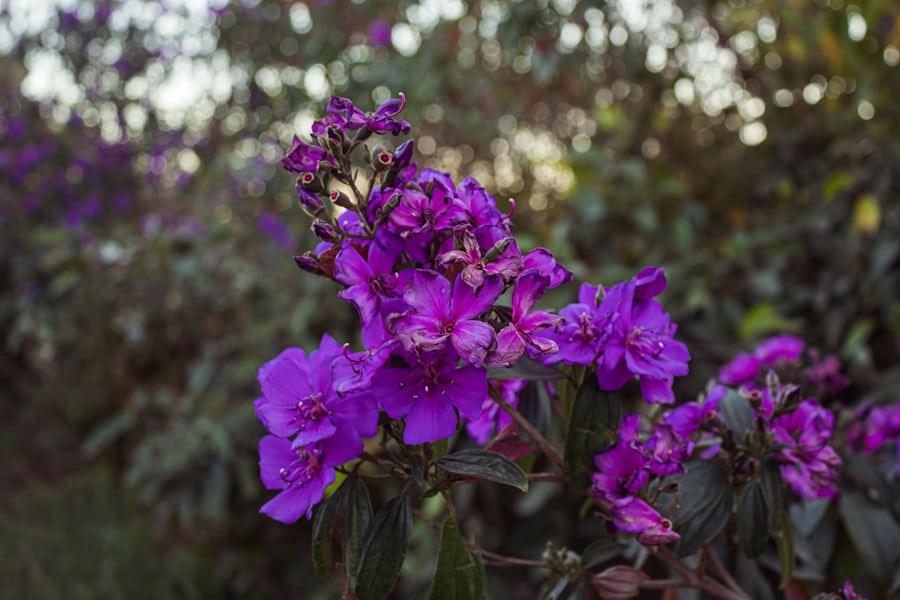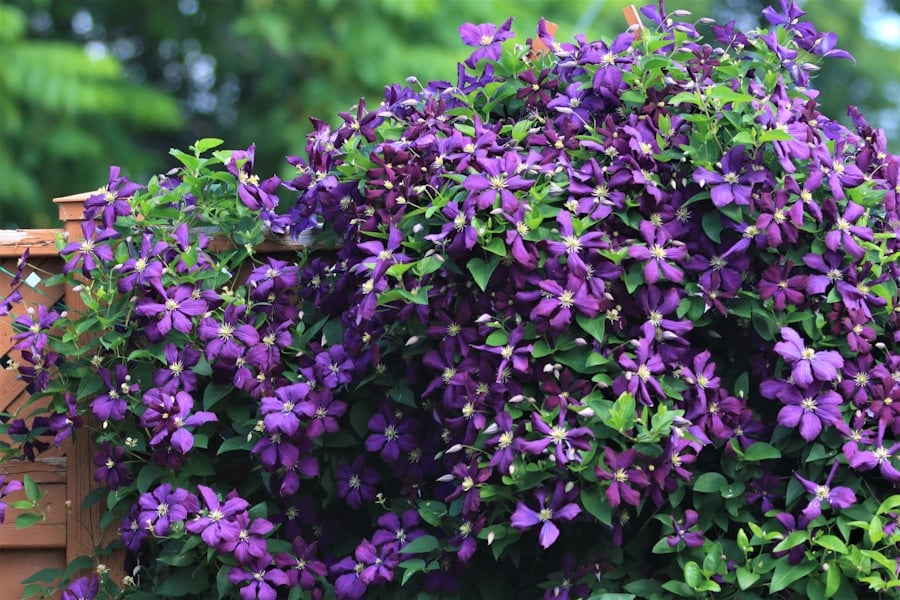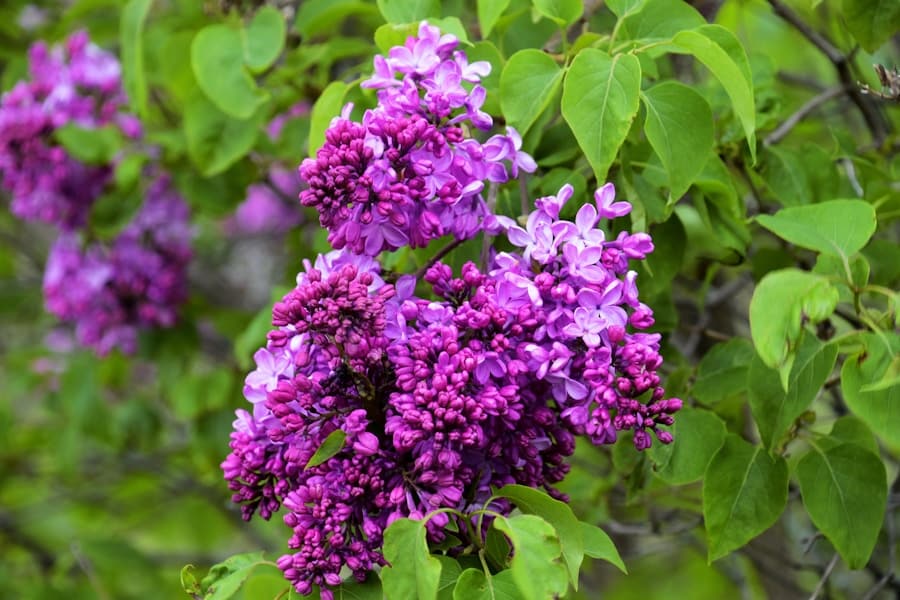As I wander through gardens and parks, I often find myself captivated by the vibrant hues of purple flowering bushes. These plants not only add a splash of color to any landscape but also evoke a sense of tranquility and beauty that is hard to ignore. The allure of purple flowering bushes lies in their ability to transform ordinary spaces into extraordinary ones, creating a visual feast for the eyes.
Whether I am strolling through a botanical garden or simply enjoying my own backyard, the sight of these enchanting bushes never fails to uplift my spirits. Purple flowering bushes come in various shapes and sizes, each with its unique charm and appeal. From the delicate blooms of lavender to the bold clusters of lilacs, these plants offer a diverse range of options for gardeners and nature enthusiasts alike.
As I delve deeper into the world of purple flowering bushes, I am continually amazed by their versatility and the myriad ways they can enhance our outdoor spaces. In this article, I will explore the characteristics, common types, identification tips, and care requirements for these stunning plants, as well as the benefits they bring to our gardens. Visit Our Site at https://chikusgarden.com/ for more information.
Key Takeaways
- Purple flowering bushes add a pop of color and beauty to any garden or landscape.
- Characteristics of purple flowering bushes include vibrant purple blooms, various sizes and shapes, and different blooming seasons.
- Common types of purple flowering bushes include lavender, lilac, butterfly bush, and rhododendron.
- Identifying purple flowering bushes involves examining the shape, size, and color of the blooms, as well as the overall growth habit of the plant.
- Purple flowering bushes can be found in gardens, parks, and natural landscapes, and are often native to specific regions.
Characteristics of Purple Flowering Bushes
One of the most striking characteristics of purple flowering bushes is their vibrant color, which can range from soft lavender to deep violet. This spectrum of shades allows me to choose the perfect hue to complement my garden’s overall aesthetic. The flowers themselves can vary in size and shape, from small, delicate blossoms to large, showy clusters that demand attention.
The foliage of these bushes often provides a lush green backdrop that enhances the beauty of the blooms, creating a harmonious balance in the landscape. In addition to their visual appeal, purple flowering bushes are often known for their pleasant fragrances. Many of these plants release sweet scents that can fill the air with delightful aromas, attracting pollinators such as bees and butterflies.
This not only adds to the sensory experience of being in a garden but also supports local ecosystems by providing food sources for these essential creatures. As I cultivate my own garden, I find that incorporating purple flowering bushes not only beautifies my space but also contributes positively to the environment.
Common Types of Purple Flowering Bushes

As I explore the world of purple flowering bushes, I encounter several common types that stand out for their beauty and ease of care. One of my favorites is the lilac (Syringa vulgaris), known for its fragrant clusters of small flowers that bloom in spring.
Its enchanting scent and vibrant purple hues make it a beloved choice among gardeners. Another popular option is the butterfly bush (Buddleja davidii), which attracts butterflies with its long spikes of purple flowers.
This bush is not only visually stunning but also serves as a magnet for pollinators, making it a fantastic addition to any wildlife-friendly garden. I appreciate how the butterfly bush blooms throughout the summer, providing continuous color and attracting various species of butterflies that flutter around my yard.
How to Identify Purple Flowering Bushes
| Common Name | Scientific Name | Height | Blooming Season |
|---|---|---|---|
| Lilac | Syringa vulgaris | 8-15 feet | Spring |
| Rhododendron | Rhododendron spp. | 3-10 feet | Spring to early summer |
| Butterfly Bush | Buddleja davidii | 6-12 feet | Summer to fall |
Identifying purple flowering bushes can be an enjoyable challenge for me as I immerse myself in the world of botany. One key feature to look for is the shape and arrangement of the flowers. For instance, lilacs typically have small, tubular flowers arranged in dense clusters, while butterfly bushes feature elongated spikes filled with tiny blossoms.
Observing these characteristics helps me distinguish between different species and appreciate their unique beauty. Another important aspect to consider is the foliage. The leaves of purple flowering bushes can vary significantly in shape and size.
For example, lilacs have heart-shaped leaves that are dark green and glossy, while butterfly bushes possess long, lance-shaped leaves with a slightly fuzzy texture. By paying attention to both the flowers and leaves, I can confidently identify various purple flowering bushes and deepen my understanding of their botanical diversity.
Where to Find Purple Flowering Bushes
Finding purple flowering bushes is an adventure in itself, as they can be found in various settings across different regions. Local nurseries and garden centers often carry a selection of these beautiful plants, making it easy for me to choose the perfect specimens for my garden. Additionally, many botanical gardens showcase a wide array of purple flowering bushes, allowing me to see them in full bloom and gather inspiration for my own landscaping projects.
In addition to cultivated spaces, I often discover wild purple flowering bushes while hiking or exploring natural areas. Some species thrive in their native habitats, adding bursts of color to meadows and woodland edges. Observing these plants in their natural environment allows me to appreciate their beauty even more and understand how they fit into local ecosystems.
Whether I am visiting a nursery or wandering through nature, I am always on the lookout for these stunning purple flowering bushes.
Tips for Caring for Purple Flowering Bushes

Caring for purple flowering bushes requires some attention and knowledge, but the rewards are well worth the effort. One essential tip I have learned is to ensure that these plants receive adequate sunlight. Most purple flowering bushes thrive in full sun, so I make sure to plant them in locations where they can soak up plenty of light throughout the day.
This not only promotes healthy growth but also encourages abundant blooming. Another important aspect of care is proper watering and soil management. While many purple flowering bushes are relatively drought-tolerant once established, they benefit from regular watering during dry spells.
I pay close attention to soil drainage as well; well-draining soil helps prevent root rot and encourages healthy root development. By providing my plants with the right conditions, I can enjoy their stunning blooms year after year.
Benefits of Planting Purple Flowering Bushes
The benefits of planting purple flowering bushes extend beyond their aesthetic appeal; they also contribute positively to the environment and enhance our quality of life. One significant advantage is their ability to attract pollinators such as bees and butterflies. By incorporating these plants into my garden, I am supporting local ecosystems and helping to sustain populations of these vital creatures.
Additionally, purple flowering bushes can provide privacy and serve as natural barriers in landscaping. Their dense foliage can create a sense of seclusion in outdoor spaces while also reducing noise pollution from nearby roads or neighbors. This makes them an excellent choice for anyone looking to create a peaceful retreat in their backyard.
The combination of beauty and functionality makes purple flowering bushes an invaluable addition to any garden.
Conclusion and Final Thoughts
In conclusion, my journey through the world of purple flowering bushes has been nothing short of enchanting. From their vibrant colors and delightful fragrances to their ecological benefits and ease of care, these plants have captured my heart and imagination. As I continue to explore different species and cultivate them in my own garden, I am reminded of the joy they bring not only to me but also to the wildlife that visits my outdoor sanctuary.
Whether you are an experienced gardener or just beginning your horticultural journey, I encourage you to consider adding purple flowering bushes to your landscape. Their beauty is undeniable, and their positive impact on the environment makes them a worthwhile investment for any garden enthusiast.
If you are interested in identifying a purple flowering bush in your garden, you may also want to check out this article on

